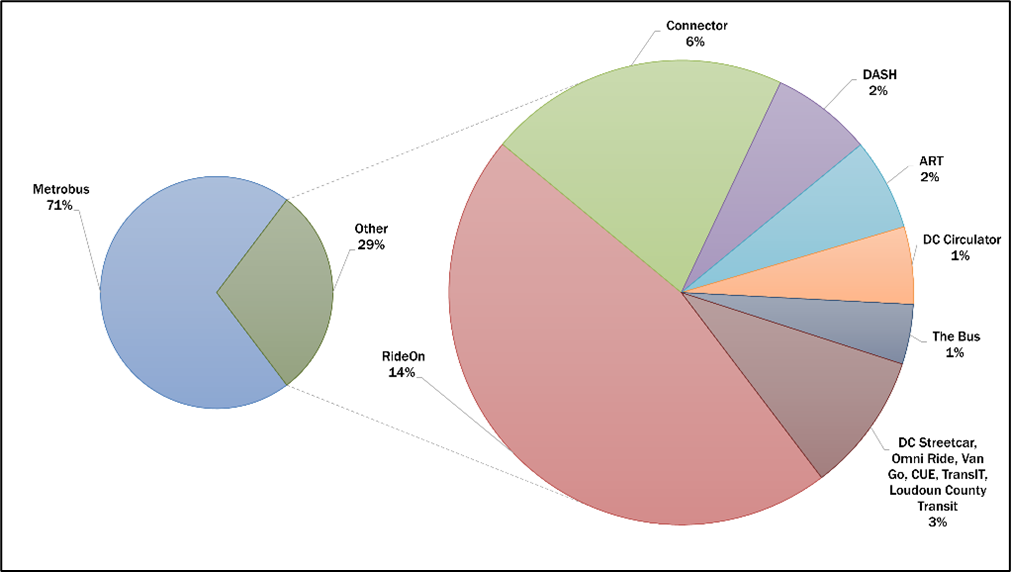The TPB’s latest State of Public Transportation Report offers a snapshot of the 2022 accomplishments and activities of the region’s fixed-route and flexible-route providers. As the habits and routines of customers continue to change in the wake of the coronavirus pandemic, many agencies are expanding their services and adopting new fare policies to increase ridership while helping financially strained customers.
A little over six percent of the region’s commuters used public transportation to travel to work in 2022. According to 2021 National Transit Database figures, bus is the primary form of public transportation in the region for unlinked transit trips. Both the percent and mode choice reflect how the region’s public transportation story has changed compared to pre-pandemic ridership patterns. As an example, unlinked passenger trips in 2021 were 65 percent less than 2020 and rail travel decreased significantly during the study period. Unlinked passenger trips, as defined by the Federal Transit Administration, are based on the number of passengers who board public transportation vehicles. Passengers are counted each time they board a vehicle no matter how many vehicles they use to travel from their origin to destination.
Many trips shift from rail to bus
Rail, bus, and paratransit are the three primary public transportation modes in the region. Metrorail offers the majority of rail transportation (heavy rail), while both Virginia Railway Express and MARC offer commuter rail service.
The Metrorail system has historically been the backbone of the region’s transit system; however, a decline in both commuter and off-peak travel as an extension of pandemic travel behavior and current telework policies means that Metrorail is still recovering from significant decreases in ridership. On a positive note, the rail network has expanded in recent years to serve more stations and provide connections that did not exist pre-pandemic. In 2022, Phase 2 of the Metrorail Silver Line Extension opened, adding 11.4 miles of track and six stations that connect to Washington Dulles International Airport and Loudoun County. In Maryland, the Purple Line light rail is anticipated to be completed in 2027.
There are 13 bus operators that form a regional network supplemented by longer-distance commuter buses. Paratransit service provides a transportation option for customers with disabilities or qualifying individuals who have difficulty using fixed-route buses and rail. While MetroAccess is the largest paratransit operator in the region, several Virginia jurisdictions operate their own local paratransit services.
WMATA’s Metro system continues to provide the greatest number of trips—79% of all public transportation rides—yet trips taken on rail versus bus have shifted. For 2022, most fixed-route bus trips were taken on the Metrobus network with Montgomery County’s RideOn as the second highest provider. Fairfax Connector conducted the third-most number of bus trips. These top three agencies account for 91% of local bus trips in the region as indicated in the chart below. The remaining 10 local bus service operators provide just over 7 million trips.

Public transportation providers in the National Capital Region (Pierre Gaunaurd/COG)
COVID and changing travel behavior
In 2022, transit agencies began to lift mask mandates and some removed dedicated COVID-related messaging from websites and customer communications. While the pandemic itself receded and more workers returned to commutes, the legacy of COVID continues. A loss of fare revenue has been the most discussed aspect of how the region’s public transportation systems have been affected. Other operations alterations with lasting impact for employees and riders include health protocols, protective barriers, and rear-door boarding.
Practices instated during the pandemic, such as fare free service, more efficient operations due to the lack of fare collection, and the availability of rear door boarding, became popular with riders. Several transit agencies began collecting fares again in 2021 and many continue to actively evaluate new fare policies. The City of Alexandria’s DASH bus service remains fare free for all riders along with the City of Fairfax’s CUE, Frederick Transit, and VanGo in Charles County.
Fare free service continues for certain groups of riders or services on Arlington County’s ART, OmniRide, Ride On in Montgomery County, and The Bus in Prince George’s County. Ride On and The Bus have also reduced their standard fares from before the pandemic. Proposed innovative service changes, such as weekend service on Virginia Railway Express and 24/7 Metrobus service on certain routes (beginning December 2023) stem from network redesign and efforts to address funding shortfalls.
Regional initiatives spark public transportation route changes, rebranding, and service expansion
Over the past several years, planners have emphasized customer service, efficient operations, and environmental sustainability through transition to clean energy sources. Notable planning, rebranding and service activities in the region during 2022 included:
- DC Circulator Electrification Plan
- Frederick County Transit 2022 Transit Development Plan Update
- Maryland Transit Administration’s locally operated transit systems (LOTS) study to assist transition to zero emission vehicles.
- City of Fairfax/CUE branding update
- Northern Virginia Transportation Authority’s update of TransAction, the long-range multi-modal transportation plan for Northern Virginia (adopted December 2022).
- Northern Virginia Transportation Commission’s Transit Resource Center Dashboard, Envision Route 7 Bus Rapid Transit Study, and Commuter Choice projects
- PRTC/OmniRide Zero Emissions Bus Study
These were but a few. A list of initiatives and service changes along with descriptions are available in the State of Public Transportation Report. The report also includes updates on the TPB’s public transportation activities and the work of the TPB Regional Public Transportation Subcommittee, plus profiles and overviews of key bus, rail, and paratransit agencies in the region.
Looking Ahead
Public transportation continues to evolve in the metropolitan Washington region in response to funding needs, employee recruitment and retention, safety considerations, capital and infrastructure upgrades, and movement away from traditional commuting days and hours. The TPB will continue to monitor and share how the region’s transit network changes over time, particularly as the longer-term legacy of the coronavirus pandemic is realized.